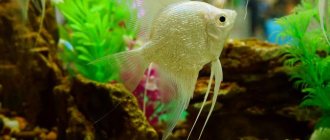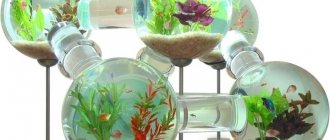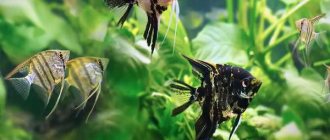Elegant South American cichlids are rightfully considered one of the most beautiful aquarium fish. The peaceful Pterophyllum Scalare looks like an angel due to the peculiar shape of its fins. This predator, originally from the Amazon and Rio Negro rivers, has been successfully bred at home for a very long time - more than a hundred years. All types of angelfish, as well as existing selective subspecies, are not inferior to each other in aristocratic gloss.
Origin of the species and description
Photo: Common angelfish
The genus of angelfish took its origin in nature from bony fish that appeared as a result of evolution 290 million years ago. Then, from the bony ancestors, 70 million years ago, all the perciformes evolved, which subsequently became so diverse that the order Perciformes is currently considered the most numerous in terms of the number of fish species (11,255 species).
Video: Common angelfish
The first literary information about scalars dates back to 1823, when they were described by the German scientist researcher Schulze, he called them Zeus scalaris. Fish began to be imported to Europe from South America in 1911, but all specimens died. Successful breeding of angelfish began much later in 1924.
Interesting fact: “In Russia, success in breeding angelfish was achieved by chance. In 1928, the owner of the angelfish A. Smirnov went to the theater, at which time the heater in the aquarium flared up and the water heated to 32°C. Returning home, a surprise awaited him: angelfish began to actively spawn.”
Currently, through the efforts of angelfish breeders, the common angelfish has received wide demand in the aquarium hobby; moreover, the bred individuals differ from the natural inhabitants in a more diverse range of body colors. The genus Angelfish is part of the family Cichlidae, the class Ray-finned, and the order Perciformes.
In nature, there are three types of angelfish:
- Ordinary;
- High;
- Leopold's angelfish.
The Latin name of the species of angelfish was received from the Austrian zoologist I.Ya. Heckel in 1840 - Pterophyllum scalare. The translation of the name into Russian sounds like “winged leaf,” which is very consistent with their external image. The most common nickname for angelfish is angelfish. The common angelfish differs from its family relatives in a number of morphological characteristics, behavior and reproductive characteristics.
Review Reviews
On the global network you can find many reviews dedicated to the maintenance and care of angelfish in home aquariums.
Most owners note the obvious advantages of these fish: beauty, original appearance, unpretentiousness, and a tendency to grow quickly.
The disadvantages, in turn, include aquarists: difficulties in breeding fish, their gluttony, difficulties in keeping them together with some representatives of the aquarium fauna.
They note that an aquarium with angelfish is a worthy decoration for the home. Despite their exotic origin, the fish are unpretentious in maintenance and care, do not require any specific conditions, grow quickly, and do not create problems for each other. Angelfish are practically omnivorous: they happily consume live and dry food, algae, and vitamin supplements.
Other owners were captivated by angelfish with their beauty and grace: you can watch them for hours. Unlike many lively fish that strive to jump out of the aquarium, angelfish are phlegmatic, swimming measuredly in the water column among the algae - this is very calming. The only problem was their breeding. As it turns out, this task can be difficult for an inexperienced person to complete.
In addition, aquarists note that there are specific nuances in keeping angelfish. Although these fish are considered peaceful, they sometimes conflict with other small inhabitants of the aquarium and can injure them. Due to these characteristics of these beautiful predators, snails and guppies may suffer. Experienced aquarists recommend placing angelfish in the same “house” only with proportionate inhabitants such as mollies and platies; they do not offend them.
To find out what types of angelfish there are and how to care for them, see the following video.
BEAUTIFUL PHOTOS OF AQUARIUM FISH - SCALARIA.
SCALARIA DISEASES: TREATMENT, SYMPTOMS, PHOTO, VIDEO, PREVENTION.
GOLDEN SCALARIA DESCRIPTION, BREEDING, COMPATIBILITY, CONTENTS, PHOTO.
SCALARIA ZEBRA DESCRIPTION, PHOTO, VIDEO.
BLACK ANCALARIA DESCRIPTION, BREEDING, CONTENTS, COMPATIBILITY, PHOTO.
SCALARIA MANAKAPURU DESCRIPTION, BREEDING, CONTENTS, PHOTO, VIDEO.
LEOPOLD'S SCALAR DESCRIPTION, CONTENTS, COMPATIBILITY, PHOTO, VIDEO.
SCALARIA ALTUM CONTENTS DESCRIPTION PHOTO REPRODUCTION
SCALARY GREEN ANGEL DESCRIPTION REPRODUCTION PHOTO CONTENTS
SCALARIA VEIL CONTENTS AND DESCRIPTION PHOTOS BREEDING COMPATIBILITY
BLUE ENGLISH DESCRIPTION PHOTO CARE
MARBLE SCALARIAN DESCRIPTION PHOTO CARE
Appearance and features
Photo: Common angelfish fish
The common angelfish has the following species characteristics:
- The body is tall, narrow, laterally flattened. The head has the shape of a triangle, with large red eyes on the sides;
- The size of the fish is average, the length of adults is up to 12-15 cm, and the height is up to 20 cm. The male and female are almost identical in parameters, the male is slightly larger;
- The dorsal and anal fins are elongated with pointed ends, due to which the appearance of the fish resembles a crescent. The pectoral fins look like long antennae;
- The body color of the common angelfish is silver-gray with a slight blue tint, against which four dark vertical stripes stand out; The first stripe crosses the eyes of the fish, the last one runs in the area of the caudal fin. The back is a darker shade.
Interesting fact: “The common angelfish is capable of changing the color of the vertical stripes on its body to a paler one. This transformation happens to her in stressful situations.”
Males and females differ little from each other. As adults, the male has a longer dorsal fin and has a fat sac on his forehead, so his forehead is rounded, while the female's is flat. Noticeable distinctive features appear only during the breeding season. The male has a pointed and narrow vas deferens under the abdomen, and the female has a wide ovipositor.
Sex differences
How to determine gender? It is impossible to distinguish between males and females before the onset of sexual maturity. And even then, it can only be reliably understood during spawning, when the female develops a thick, cone-shaped ovipositor.
Indirect signs are deceptive, the male is lobbier and larger, especially since females can create a pair if there are no males. And this pair will behave in exactly the same way, right down to imitation of spawning. So you can only determine the sex of adult fish, and even then with some relativity.
Where does the common angelfish live?
Photo: Angelfish fish
The common angelfish is a freshwater tropical fish. Its permanent habitat is the reservoirs of the South American continent, the basin of the world's largest river, the Amazon, stretching from Peru to the eastern shores of Brazil, and the paradise Orinoco River. Sometimes it is also found in the form of small populations in the rivers of the Guiana and Brazilian plateaus.
The Amazon territory is considered an ideal habitat for angelfish, as it constantly has high water temperatures, which is extremely important for the reproduction of these fish. In its waters they coexist with other friendly inhabitants of these fascinating places, for example: guppies, swordtails, neons, and discus fish. All together they make up a huge number of river inhabitants - more than 2.5 thousand.
The angelfish population prefers to live in narrow channels of slow-flowing rivers, river backwaters, swamps and flooded river valleys. A prerequisite for their habitat is aquatic thickets.
When breeding, common angelfish lay their eggs on the wide leaves of aquatic plants, so they prefer to live in reservoirs with dense vegetation, among which the growing young can just as easily hide from enemies.
Ideal conditions
These tropical fish, no more than 15 cm long, require a water temperature of 24 to 28 degrees. PH value from 6 to 7.5. A tall aquarium with a volume of at least 100 liters will ensure good health for angelfish.
Due to the fact that all “freshwater angels” are quite peaceful, they can easily get along with catfish. Also good companions will be Lyalius, Blue Gourami, Shark Baloo and Zebra Pleco. When choosing companions for angelfish, you should pay attention to fish with the same low level of aggressiveness . Since cichlids are schooling fish, it is highly not recommended to keep them alone. It is better to buy individuals in pairs - 2, 4, 6, etc. In nature, angelfish live in schools of two dozen fish.
What does the common angelfish eat?
Photo: Angelfish
In their natural environment, common angelfish act as predatory fish.
The basis of their daily diet are the following animals:
- small invertebrates – daphnia, cyclops, tubifex;
- small insects and their larvae living on the surface of the water;
- fry of other small fish.
Trying to overtake the prey, angelfish develop great speed, which they easily achieve with the help of their narrow body and long, strong fins. Despite the fact that these fish spend a lot of time hiding in algae, they are not used as a nutrient substrate, since they need protein food.
Larvae of the common angelfish use the contents of the yolk sac as a nutrient substrate. As they transform from larvae to fry, they gradually switch to feeding on small plankton. The matured fry learn to hunt larger prey, with the help of their parents.
Currently, angelfish are widely recognized and used as ornamental fish in aquariums, where they are fed with a combination of meat ingredients (bloodworms, mosquito larvae) and herbal supplements (pieces of spinach and lettuce). Food can be in the form of dry flakes, as well as live and frozen.
Similar fish
Along with the usual angelfish (Pterophyllum scalare), another species began to appear on sale some time ago - Pterophyllum altum. These fish are very similar to angelfish in appearance, but are much more demanding in terms of keeping conditions, and can only be recommended to professional aquarists.
High angelfish (altum). Pterophyllum altum.
Features of character and lifestyle
Photo: Angelfish
Angelfish are ordinary peaceful inhabitants of tropical waters. They prefer to live in flocks, in which pairs form between males and females. A notable feature in angelfish couples is their lifelong devotion to each other.
Interesting fact: “If one of the spouses dies in a couple, then the one who remains alive will never look for another life partner.”
Representatives of the common angelfish species lead a diurnal lifestyle, spending most of their time among aquatic thickets. Thanks to their flattened body, they easily swim between algae thalli, and vertical stripes on their body serve as camouflage.
During the day they get food while hunting, and at night they rest, hiding in thickets of aquatic vegetation. Before hunting, angelfish are grouped into small flocks. They hide in algae waiting for prey. When suitable food appears on the horizon, they rush to it in a flock and tear it into pieces.
Outside the breeding season, sexually mature individuals are quite peaceful neighbors. But during the spawning period they are especially aggressive, trying to protect their territory and offspring. It is interesting that the male and female care for the eggs and fry together.
Compatibility
Angelfish are considered quite friendly neighbors, but these are cichlids, and you need to remember this when choosing small fish as neighbors - they can become a snack.
Aquarium fish angelfish are considered sociable fish, but can be aggressive towards small neighbors. While angelfish are young, they are quite peaceful, but as they age, they become a territorial fish. When they pair up, they become aggressive and fiercely defend their breeding territory.
Avoid proximity to aggressive biting fish - they can encroach on the “wings” (fins) of angels.
Social structure and reproduction
Photo: Common angelfish
In the population, angelfish become sexually mature individuals in the period from 8 to 12 months of life. With the onset of the spawning period, pairs are formed between them, which occupy a specific territory in their habitat and prepare for reproduction. To do this, they find a place where they will lay eggs. This could be a stone or a wide part of an aquatic plant. Together they clear it of debris and plaque over several days, and then lay large, light-colored eggs on its surface.
On average, a female angelfish can lay 150-200 eggs. Next comes a difficult period of protecting their offspring, which the male and female also experience together. They remove dead eggs and cleanse living ones. They protect them from attacks by other fish. Two days later, larvae emerge from the eggs, which remain glued to each other and are under the protection of their parents. If a threat suddenly appears, the male and female can even carry them in their mouths to a safe place.
Within two weeks, the larvae transform into fry. For some time, caring parents continue to care for their immature offspring. They gather the fry into a group and accompany them, protecting them from danger. They help crush large plankton so that the fry can eat. Based on the behavior of angelfish during the mating season, we can confidently call these fish real intellectuals of the underwater world. Life time in natural conditions and in captivity is approximately 8-10 years.
Dilution water parameters
To begin with, it is worth mentioning the water parameters for the life of angelfish:
- Aquarium volume – starting from 100 liters per couple. It is generally accepted that several angelfish can be housed in a much smaller volume, but this is not the case. For full and harmonious development, the volume of the aquarium must be at least 90 liters, and the aquarium itself must be high enough
- Temperature 22-27°C
- Hardness up to 10
- Acidity 6-7.5
- Aeration, filtration, weekly water changes and soil cleaning
- Keeps 7-8 pieces in a flock
At first, the secret of successful breeding of angelfish was kept secret for a long time. Today this difficult process is known inside and out, but still not all aquarists can do it.
In the spawning area for angelfish, other parameters are created:
- Temperature 27°C. To stimulate spawning, the temperature is raised to 32°C.
- Feeding with live food
- Regular water changes
- Soft water is recommended, however, if spawning does not occur, you can try replacing it with hard water: in some cases this is the decisive factor
- Cone or other hard surface. Angelfish, like discus fish, prefer to lay their eggs on something cone-shaped. In the absence of such an object, they, of course, will be able to lay eggs on a plant leaf. But the cone will significantly increase the number of hatched fry.
Fish can also spawn in a community aquarium. It is not necessary to place the pair in a spawning tank.
Natural enemies of common angelfish
Photo: Male angelfish
Living in the rivers of the Amazon, the common angelfish encounters its natural enemies there. Since the fish is relatively small in size, it can become prey for both large fish species and medium-sized representatives of river fauna.
These fish include:
- piranhas, which are particularly voracious and have very sharp teeth, with which they can even bite a finger or a stick;
- Payara is a little-known fish that has two pairs of sharp teeth, one pair of which is visible, and the other is folded inside the jaw, and also has a good appetite;
- Aravana is a large predatory fish, lives in the backwaters of rivers with stagnant water and feeds on the fish living there.
Caimans can also be classified as enemies of angelfish. Due to their small size, they often have to rely on small fish as a source of food. In the struggle for life, the angelfish was able to adapt in the process of evolution.
Her main “trump cards” in the battle with enemies are:
- flattened body for easy maneuvering between algae;
- strong, long fins that allow you to quickly develop high speed;
- Vertical contrasting stripes on the body help camouflage among algae thalli.











